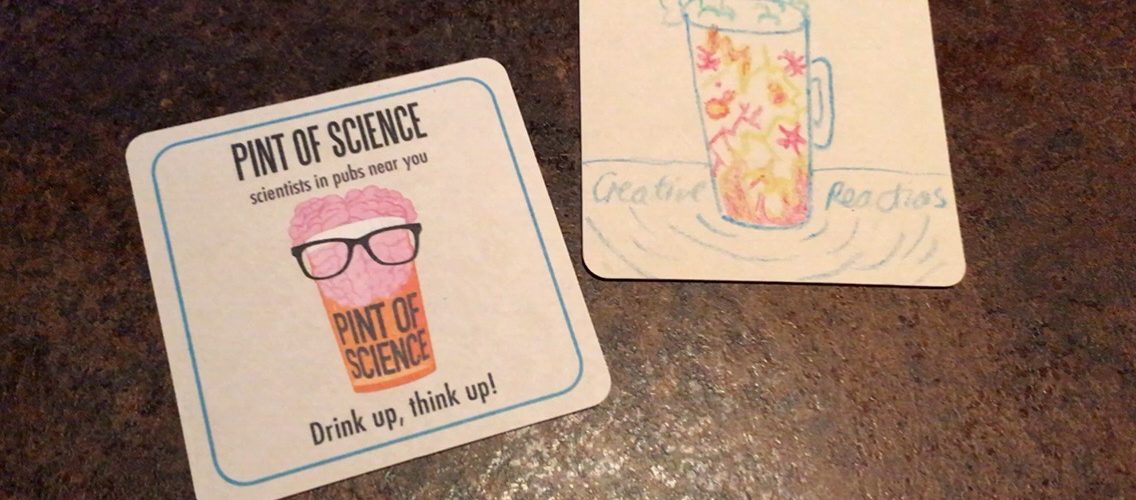Identity and Psychology: Part 1

Trigger warning: this article contains sensitive information regarding trauma/suicide
‘Our society’ was one of the many interesting themes from this years Pint of Science festival. The start of the festival kicked off with some interesting psychology, specifically focusing on occupational trauma and suicide.
Dr Kevin Wilson Smith was the first speaker of the night with his talk titled ‘Identity and Trauma’. Kevin is a lecturer at Glasgow University who completed his PhD in London and worked as a military psychologist in the army.
“Who are you?”
This was the thought provoking question Kevin chose to start with. Kevin described himself as an academic, a father, a son, a husband, a member of the military and a fun guy. Let’s put the question to you. Have a think about how you would describe yourself…
Kevin then went on to define trauma and explained that people’s perception of trauma is often very different. In the military world, it is often expected that after experiencing significant trauma on the job you should be able to return home and simply “get on with it”. The concept of the ‘snowflake generation’ was then introduced. Kevin believes this is wrong, people are not in fact ‘snowflakes’ but have feelings that should be recognised. Post-traumatic stress disorder, PTSD, is now better diagnosed due to growing research and interest in the subject, particularly in the US. Studies have found that trauma can indeed change the way a person sees the world1. It has also been shown that suicide rates from military personnel are very high. However, this has been shown to not necessarily be associated with the trauma itself, but rather due to a lack of a support network. This lack of support can contribute to ill health, that in some cases can lead to suicide (We find out much more about suicide risk factors later in the evening).
Examples of trauma can also be applied to other occupations, such as midwifery. Midwives are exposed to many traumatic events in their job, such as stillbirth, and Kevin questioned how they continue to function after experiencing these traumatic events. He followed this up by asking the audience their own perception of midwives. I can’t speak on behalf of the audience, but I’m guessing many thought about the positive aspects of the job, forgetting the very difficult parts of the occupation. Kevin then introduced us to the clinical trial, called the PROMISE trial, which investigated recurrent miscarriage and stillbirth. Women enrolled in the trial were given progesterone supplements (for a long time thought to decrease the chance of miscarriage after previous miscarriages or a placebo drug to take in their first trimester of pregnancy. Unfortunately, those on progesterone were found to be no less likely to miscarry than those who had taken the placebo. As much as the experience and study findings were likely heartbreaking for the women involved, Kevin reminded us that the midwives supporting those in the trial may have also found it traumatic and disappointing2.
Bringing it back to the military theme, Kevin spoke about similar trials in the military setting. One particular study Kevin addressed was one which was focused on adjustment back into normal life after deployment. A quote from one trial participant was “f*** the apples!”, on the surface an amusing quote. This came from a military professional who became a supermarket delivery driver after his time in the army. During a delivery, a certain delivery was missing a pack of apples, the customer for whom the delivery was for became distressed about a missing pack of apples, causing the driver to make the statement above. This quite clearly demonstrates how perspective can change in someone who has experienced trauma. What is a missing pack of apples when you have witnessed colleagues die around you? Trauma can evidently make people re-evaluate what is important.
Another area of research which is becoming popular in the military field is phenomenological analysis. This focuses on the structures and experiences of consciousness from first-person accounts3. Kevin went on to address one of the major challenges in psychology research. It can be hard to reproduce when they are based on personal experiences. However, does that mean it is poor science? A common challenge is translating one person’s story to a whole population. When considering the main occupations followed throughout the talk, it may be easier to translate this type of qualitative research, for midwives. This was highlighted in a study which found midwives tended to use ‘we’ not ‘I’ at work. Yet, for individuals in the army, work can be more isolating and varied, therefore making it harder to translate findings from studies between the two occupations. In occupations dealing with trauma, documenting conversations behind the scenes can be extremely insightful. It has been shown that in jobs such as the army or emergency medicine, humor plays a significant role in daily conversations. Understandably, this can be a huge coping mechanism.
What can this tell us about the needs of those in occupational settings dealing with regular trauma? Kevin passionately described why this type of research is extremely important. The desired impact would be exemplifying the need for training and educational resources in these jobs, such as grief training for midwives. An example of where this has worked is with TRiM- trauma risk management. This is a peer delivered system for those in the military where people are trained to recognise likely triggers of trauma and how to effectively risk assess these situations. This will aid in identifying those in need of intervention after trauma much earlier4.
The last topic of Kevin’s talk was the concept of identity transition – how do you lose one part of your identity and move on? It has been found that there is a correlation between wealth and coping better with transition. Often, soldiers (lower in the army ranks) will find the transition much harder than officers. This may be due to officers having a higher income and therefore having easier access to support services and treatment if necessary. Yet, this concept of a transition suggests that identity is hierarchical, that only one identity can exist at any one time. However, many would say, people can exist happily with numerous identities at once – just as Kevin had introduced himself at the beginning of his talk.
To finish this section of the evening and remind us all of the validity of individual accounts in this research area, Kevin left us with us a brilliant analogy – we don’t need 540 Anne Frank diaries to understand what happened and learn from it. Sometimes, one person’s story is enough to learn from.
This article was edited by Sonya Frazier.
Read Part 2 here: https://the-gist.org/2019/06/identity-and-psychology-part-2/ .
References
- https://www.scitechnol.com/peer-review/identity-and-trauma-FBG5.php?article_id=5034
- https://www.miscarriageassociation.org.uk/research/the-promise-trial/
- https://www.tandfonline.com/doi/full/10.1080/01494929.2015.1124353
- https://strongmindresilience.co.uk/courses/trauma-risk-management-trim-an-overview/










